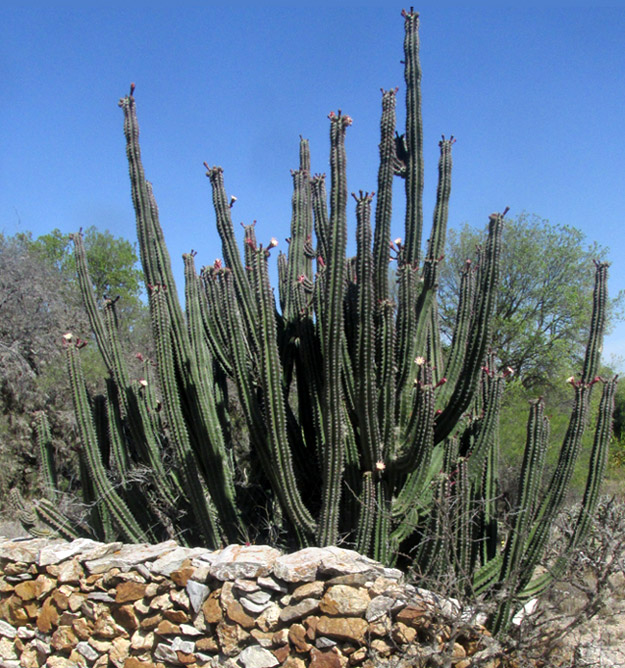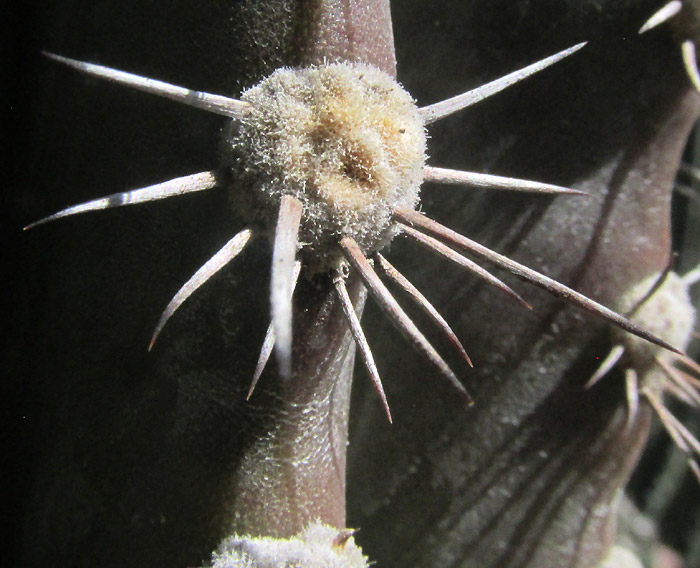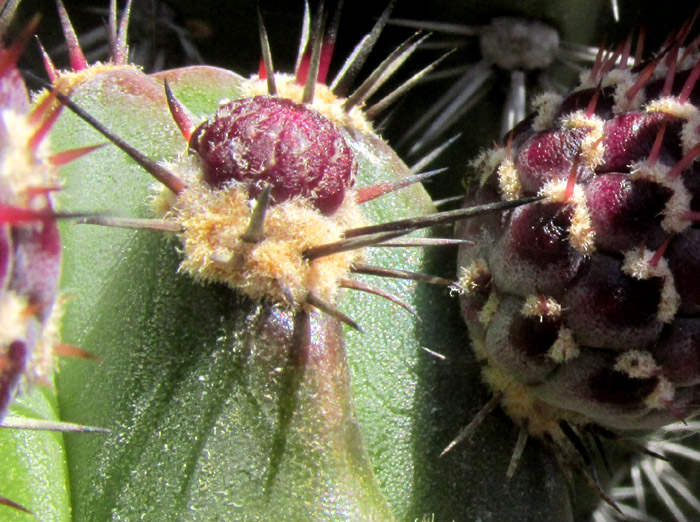Excerpts from Jim Conrad's
Naturalist Newsletter
Entry dated March 7, 2024, from notes taken about 2kms south of Higuerillas, Municipality of Cadereyta de Montes; N20.8872°, W99.7718°, elevation ~1660 meters (~5450 feet); rocky soil derived from bedrock of limestone and limy mudstone; local narrow belt of vegetation constituting an extreme southern extension of the Chihuahuan Desert, Meridional Subregion; central Querétaro state, MÉXICO
STENOCEREUS HUASTECORUM

On the valley's alluvial floor, an old spring provided enough water to create a green oasis of a few modest ranchos. Each property was surrounded by barbed-wire fences or low stone walls, keeping roving feral burros out, and keeping in any livestock they might have. The above cactus grew beyond a wall I was unable to cross for a view of the whole plant. Seeing no other cacti of this species in the area, I wondered whether it might have been planted. However, I was pretty sure I'd seen this species growing in the wild elsewhere here in the Querétaro mountains (following entry), though this was the first one I'd seen bearing flowers.

The pinkish blossoms were about 10cm long (4 inches), with somewhat spherical, scaly ovaries looking like little purplish pineapples, but bristling with short spines.

The fuzzy-whitish areoles were distinctively rounded, each areole producing nine or so radial spines, and three or so central spines, which weren't really central but rather growing from the areole's bottom half and projecting downward. All spines were relatively short.

Above, an areole is accompanied by a young flower bud. On the picture's right there's a developing ovary with short spines. I read that when the fruit matures, the spines are deciduous. Mature fruits I've seen have borne spines (next entry), but apparently the spines easily are removed, for the fruits are much sought for eating, and appear in local markets spineless.
In the next section, written in 2007, you'll see that at that time I gave it another name. In fact, until fairly recently there's been confusion about what to call this cactus. However, the 2018 study by Hermán Avarado-Sizzo and others entitled "Species delimitation in the Stenocereus griseus (Cactaceae) species complex reveals a new species, S. huastecorum," clears things up somewhat. Accompanying detailed descriptions of the several species involved are distribution maps and close-up photos, all indicating that our cactus is STENOCEREUS HUASTECORUM, with no English name. It's endemic just to northeastern Mexico from Nuevo León and Tamaulipas south to about here in Querétaro.
The name Stenocereus haustecorum wasn't published until 2018, explaining why it doesn't occur in older accounts of the species' traditional uses in Mexico. There's no doubt that earlier and even today many Mexicans relish the sweet fruits and collect them from the wild.
Probably the taxon has been used in traditional medicine, too. The 2022 study by Y. Ramírez-Rodríguez and others entitled "Stenocereus huastecorum-fruit juice concentrate protects against cisplatin-induced nephrotoxicity by nitric oxide pathway activity and antioxidant and antiapoptotic effects," reports that Stenocereus huastecorum fruit juice "attenuated renal dysfunction and structural damage." Also, it showed antioxidant and other potentially beneficial properties.
from the June 15, 2007 Newsletter issued from Jalpan de Serra, N21.23°, W99.47°, elevation ~800m (~2600ft); Sierra Gorda Biosphere Reserve, QUERÉTARO, MÉXICO
ORGAN-PIPE OASIS

Early that morning, high up the scrubby slope west of town, I heard drawn-out, nasal ZWEEIRS amid varied twittering warbles: A strikingly yellow-bottomed, black-topped, male Lesser Goldfinch in full courtship plumage (black-backed form) accompanied his somewhat less stunningly colored mate inside a kitchen-size thicket of candelabra-like organ-pipe cacti. The birds feasted on the cacti's globular, red, sublimely spiny fruits, shown above.
Before I could get into position with my binoculars to see how the birds were handling such spiny fruits, they'd flown away. I could see clearly, though, that nearly all the mature fruits had been split open. The goldfinches had been feeding in the fruits' open wounds, but I couldn't be sure whether the goldfinches or something else had made the deep gashes.
A couple of weeks earlier I'd been riding with my friend Pancho as we'd passed a cluster of organ pipes. Pancho had smacked his lips and said it wouldn't be long until the pitayas would be ripe. They were ripe now and the goldfinches were eating them. I'm sure Pancho could have knocked one or two fruits down and expertly opened them so that the glistening, crimson, strawberry-like flesh could be eaten without getting spines in our fingers and lips, but I was alone that day and I knew from experience to not even try.
People here call all large cacti with definite trunks and upward rising arms órganos, (organ-pipe cacti), and this was one of those. I'm pretty sure it was the endemic STENOCEREUS QUERETAROENSIS. (*see note at right)
The Goldfinches didn't return but for half an hour two Broad-billed Hummingbirds zipped about the cactus copse dipping their red, black-tipped bills into the pitaya gashes as if the pitaya were flowers, not fruits. Instead of pecking at the flesh they appeared to sip the sweet juice glistening on the exposed pitaya flesh. The birds were mostly green and black and the male's gorget shimmered iridescently blue. How pretty it all was, the birds, the green cactuses soaring around them, the red fruits, the blue sky beyond.
The hummingbirds competed for the sweet pitaya juice with honeybees and flies. In fact, often a hummer would hover before a gashed pitaya a few seconds but then move on, there being too many honeybees clustered there with no inclination to move on.
A Brown-crested Flycatcher glided in and staged a foray or two past fly-orbited pitayas. A White-winged Dove on whistling wings fluttered onto a branch and parked himself so that nothing showed through a slit between two órgano arms but his glassy, amber-colored eye surrounded by a blue goggle looking exactly at me.
So, here's how it seemed to me: That morning, that entire slope was so dry it was next to dead, awaiting rain. But there was an oasis of life in one tiny spot, right there where a handful of organ pipes grew. But those cacti wouldn't have meant anything if their pitayas hadn't been gashed. Had the goldfinches cut the fruits open, or woodpeckers, or maybe bats or rodents in the night?
What a thing, that so much life depended on a few gashed pitayas!